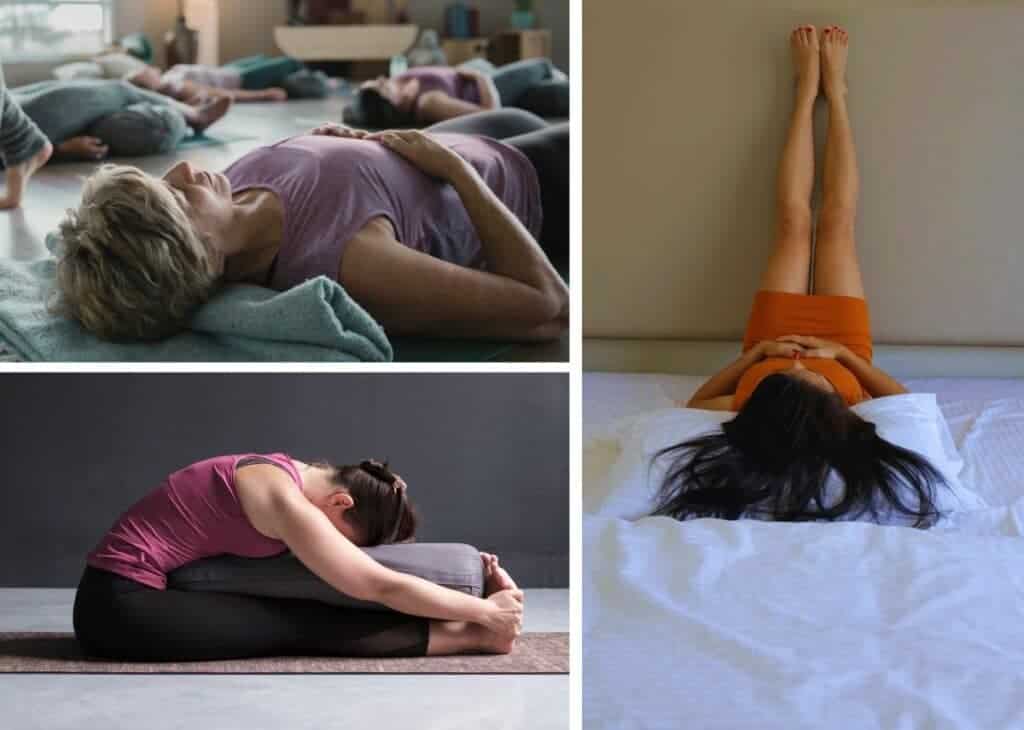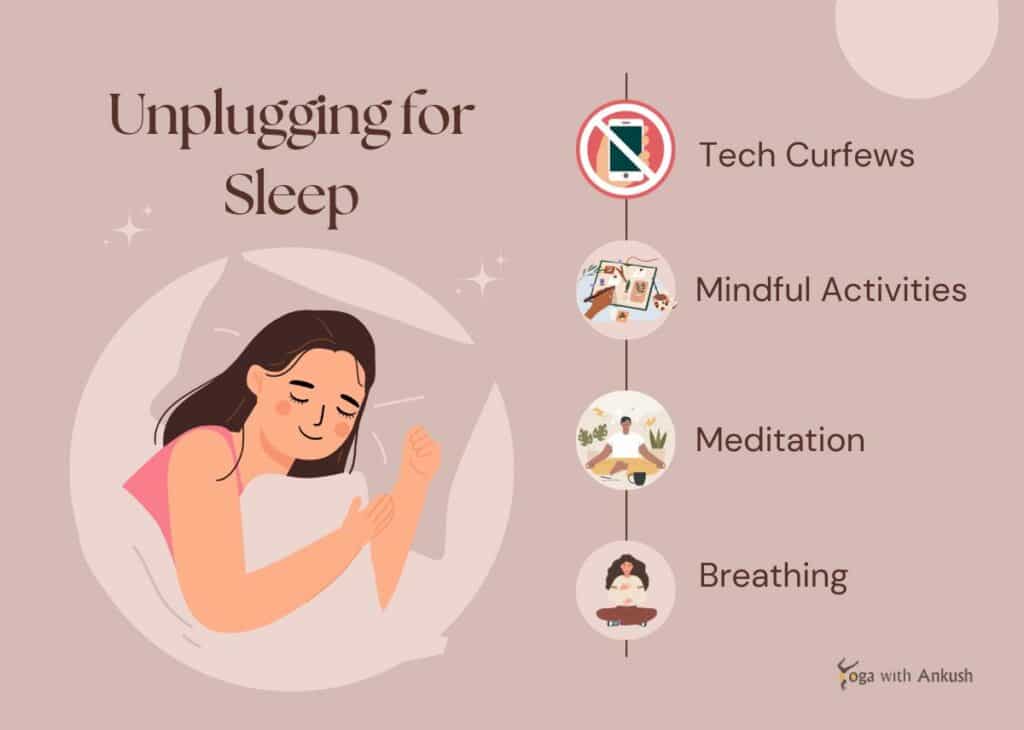In our hyperconnected, fast-paced world, quality sleep often feels like a distant dream. Between deadlines, notifications, and anxieties, achieving the restorative slumber our bodies crave can be a frustrating battle.
Thankfully, nestled in the ancient wisdom of yoga lies a treasure trove of tools and techniques designed to combat insomnia and unlock the door to deep, rejuvenating sleep.
Beyond physical stretches and postures, yoga is a holistic practice encompassing breathwork, meditation, and mindfulness. This harmonious blend creates a powerful synergy that addresses the root of sleep disturbances – stress, anxiety, and hyperactivity.
Let’s delve into the transformative power of yoga, exploring specific practices and revealing how they can guide you towards peaceful slumber.
Table of Contents
Yoga for Deep Sleep
Calming the Storm: Yoga Poses for Relaxation
Gentle Flow: Unlike the vigorous Vinyasa style, slow, mindful movements like Sun Salutations B and C, Swan Pose, and Child’s Pose, activate the parasympathetic nervous system, inducing relaxation and calming the mind. Hold each pose for several breaths, focusing on the connection between breath and movement.
Yin Yoga: This meditative practice features supported postures held for longer durations, often using props like blocks and bolsters. Yin targets deep connective tissues and the nervous system, releasing tension and promoting profound relaxation. Poses like Caterpillar, Sleeping Swan, and Supported Sphinx Pose are perfect pre-sleep companions.
Restorative Yoga: Similar to Yin, restorative yoga prioritizes relaxation over movement. Utilizing props to fully support the body, poses like Supine Supported Fish Pose, Legs-Up-the-Wall Pose, and Forward Fold with Bolsters allow deep release and surrender, preparing the body and mind for restful sleep.

Quieting the Chatter: Breathwork for Inner Peace
Diaphragmatic Breathing: This deep, rhythmic breathing technique activates the relaxation response, slowing the heart rate and calming the mind. Lie down comfortably, place one hand on your abdomen and the other on your chest. Breathe deeply into your belly, feeling the hand on your abdomen rise and fall. Repeat for several minutes, focusing on the rhythm and letting go of tension.
Nadi Shodhana: This alternate nostril breathing technique (also known as Pranayama) balances the flow of energy in the body and promotes mental clarity and calmness.
Sit comfortably with your spine straight. Use your thumb and ring finger to close one nostril at a time, inhale through one nostril, exhale through the other, alternating sides for several rounds.
Meditation: Whether seated or lying down, dedicate a few minutes to silent meditation. Focus on your breath without judgment, allowing thoughts to arise and gently pass without attachment. This practice cultivates inner stillness and prepares the mind for restful sleep.
Also Read: How to Meditate – Simple meditation for beginners
Beyond the Mat: Cultivating Sleep Hygiene
While yoga poses and techniques provide powerful tools, remember that sleep hygiene plays a crucial role. Implement these additional practices for enhanced sleep quality:
- Establish a regular sleep schedule and stick to it, even on weekends.
- Create a relaxing bedtime routine, including winding down with gentle activities like reading or taking a warm bath.
- Avoid screens and stimulating activities for at least an hour before bedtime.
- Make sure your bedroom is dark, quiet, and cool.
- Avoid caffeine and alcohol before bed.
- Get regular exercise, but not too close to bedtime.
Your Personal Sleep Sanctuary: Experiment and Adapt
Remember, your yoga practice is a personal journey. Explore different poses, breathing techniques, and meditation practices to discover what works best for you. Be patient, listen to your body, and adjust your routine as needed.
Yoga isn’t a quick fix, but a practice that cultivates a harmonious relationship with your body and mind. As you weave yoga into your life, you’ll not only find yourself falling asleep faster and sleeping more soundly, but also experiencing a deeper sense of calm and well-being that transcends the bedroom, flowing into every aspect of your life.
Beyond the Words: Personal Anecdotes and Sharing Your Journey
As a yoga teacher and passionate advocate for holistic wellness, I’ve witnessed firsthand the transformative power of yoga for sleep. Through gentle flows, restorative postures, and mindful breathing, I discovered a newfound ability to quiet my mind and drift off to sleep with ease.
This personal journey fueled my passion to share this knowledge with others, witnessing students transform their relationship with sleep and their overall well-being.
The stories of countless yogis I’ve encountered echo my own experience. From weary executives finding newfound peace to overwhelmed mothers experiencing deeper sleep and more patience, the benefits of yoga for sleep are undeniable.
Sharing these anecdotes and personal stories in your article adds a relatable human touch, helping readers connect with your message and envision themselves experiencing similar transformations.
Embracing Mindfulness in a Digital Age: Unplugging for Sleep
In an era dominated by smartphones, notifications, and the constant blue light glow, disconnecting and finding stillness feels like a modern-day superpower. Yet, it’s this very ability to unplug and cultivate inner peace that holds the key to unlocking restorative sleep in our tech-driven world.
Yoga offers a haven in this digital storm. By stepping off the virtual treadmill and onto the yoga mat, we create space for mindful awareness, allowing us to observe our thoughts and anxieties without judgment and eventually let them go. This conscious unplugging extends beyond the practice, influencing our relationship with technology even beyond the yoga studio.

Smartphone Silhouettes: Implement “tech curfews,” silencing notifications and powering down devices at least an hour before bedtime. Create a designated “tech-free zone” in your bedroom, a sanctuary solely for sleep and relaxation.
Digital Detox Delights: Replace screen time with mindful activities like journaling, reading a book (not on your Kindle!), listening to calming music, or even savoring a cup of herbal tea. Prioritize real-world connection, fostering conversations with loved ones or enjoying quiet moments in nature.
Meditation for Mindful Mornings: Start your day with a brief meditation practice, setting the tone for a day grounded in awareness and presence. This simple act of inward focus helps manage stress throughout the day, preventing its ripple effects from disrupting your sleep later.
Breathing Beats the Buzz: Whenever you feel overwhelmed by digital overload, take a break. Step away from the screen, close your eyes, and practice a few minutes of diaphragmatic breathing. Feel the calming rhythm of your breath wash over you, grounding you in the present moment and easing digital anxieties.
Remember, the journey towards better sleep through yoga is an ongoing practice. Embrace experimentation, explore different techniques, and most importantly, listen to your body’s wisdom. As you weave yoga and mindful practices into your daily life, you’ll gradually cultivate a digital disconnect that not only leads to restful sleep, but also fuels a greater sense of inner peace and awareness, a welcome antidote to the ever-present hum of the digital world.
Also Read:







